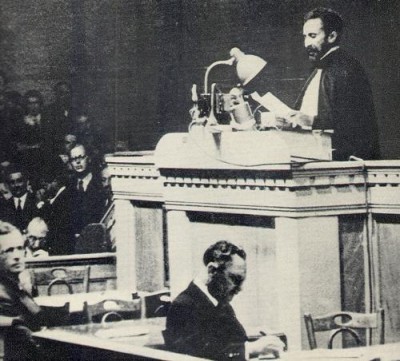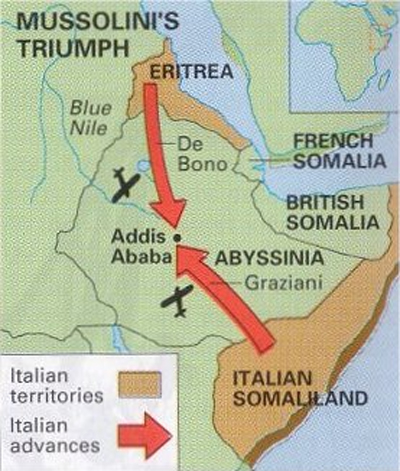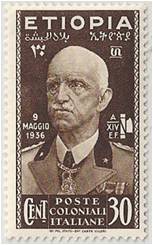ALBUM – View my Italian Occupation of Ethiopia album
Fast Facts
Region: Eastern Africa
Group: Italian East Africa
Classification: Military Occupation (Italy)
Prior Regime: Empire of Ethiopia
Key Dates:
1935, Oct 3 – Italy invades Ethiopia
1936, May 5 – Italy takes control of Addis Ababa, Ethiopia’s capital
1936, May 9 – Italy annexes Ethiopia
1936, Jun 1 – Ethiopia, Eritrea, and Italian Somalia are joined to create Italian East Africa
1941, Sep 1–5 – Addis Ababa liberated by Allies.
1942, Jan 14 – Last Italian forces surrender
Following Regime: Italian East Africa
Scott Catalogue: (Ethiopia) #N1-N8
Pick Catalogue: none
History

As fascism took power in Italy led by Benito Mussolini, Ethiopia became a prime target of expanding the vision of a greater Italian Empire. In addition to creating a larger presence in East Africa by unifying Italy’s territory in Eritrea and Italian Somaliland, Mussolini longed to avenge the military humiliation decades earlier.
A border clash between the two countries in Dec, 1934, known as the “Wal Wal incident”, gave Italy an excuse to expand into Ethiopia. Haile Selassie appealed to the League of Nations for support, but the organization had no ability to resolve the dispute, and Italy continued to build up forces on the border for an eventual attack. Salassie’s appeal propelled him onto the world stage, winning him world respect, and the honor of being Time’s “Man of the Year” in 1935. Eventually, on 4 Sept, 1935, the League of Nations “exonerated both Italy and Ethiopia of any culpability in the Wal Wal incident”.
Rejecting all attempts at arbitration, Mussolini invaded Ethiopia on 3 Oct, 1935, attacking from both Eritrea in the north and Italian Somaliland in the south. Ethiopia again appealed to the League of Nations, which condemned the Italian invasion and voted to impose economic sanctions. However the sanctions were never really implemented as France and Britain were trying to keep Italy as an alley against Germany in the anticipated upcoming conflict in Europe.
 The well trained Italian forces slowly overwhelmed the poorly trained Ethiopian army, eventually taking the capital seven months later on 5 May, 1936. Emperor Haile Selassie went into exile, Italy annexed Ethiopia, Italy’s puppet king Victor Emmanuel III was proclaimed emperor of Ethiopia, and Pietro Badoglio, one of the victorious generals, was appointed as “Duke of Addis Ababa”.
The well trained Italian forces slowly overwhelmed the poorly trained Ethiopian army, eventually taking the capital seven months later on 5 May, 1936. Emperor Haile Selassie went into exile, Italy annexed Ethiopia, Italy’s puppet king Victor Emmanuel III was proclaimed emperor of Ethiopia, and Pietro Badoglio, one of the victorious generals, was appointed as “Duke of Addis Ababa”.
Less than a month after the annexation, in June of 1936, Italy brought together Ethiopia, Eritrea, and Italian Somaliland and created Italian East Africa, a single administrative unit divided into six provinces.
On June 30th, Haile Selassie made a powerful speech before the League of Nations in Geneva, setting forth two choices for the Assembly: Act to support a collective security or Fall into international lawlessness. The emperor stirred the conscience of world, but political realities soon overwhelmed any moral arguements. Britain and France soon recognized Italy’s control of Ethiopia, but others such as the United States and the Soviet Union refused to do so.
The existence of Italian East Africa was short lived. With Italy’s entry into World War II as part of the Axis Alliance in Sept 1940, British forces, together with patriot Ethiopian fighters, liberated Ethiopia in the “East African Campaign”. In Jan 1942, with the official surrender of the Italians, an interim Anglo-Ethiopian Agreement was signed with Emperor Haile Selassie I acknowledging Ethiopian sovereignty.
Stamps
 ALBUM
ALBUM
On 22 May, 1936, three stamps were issued (25c, 30c and 50c) featuring the image of Emperor Victor Emmanuel III. Later in the year on 5 Dec, four additional stamps were issued (10c, 20c, 75c and 1.25l) also featuring Victor Emmanuel with a backdrop scenes of Ethiopia.
All of the stamps were inscribed in Roman, Arabic and Amharic scripts, and included the date: 9 May, 1936 to commemorate the day that Ethiopia was annexed by Italy.
The occupation stamps were replaced with Stamps of Italian East Africa on 7 Feb, 1938.
Banknotes
No specific banknotes were issued for the military occupation, but after the creation of Italian East Africa, four notes were issued using the Italian East Africa Lira.
Links
Second Italo-Ethiopian War from Wikipedia
The Italo-Ethiopian War: 1935–1936 and 1936–1939 from Colonial Warfare
Stamps of Ethiopia – Italian occupation of Ethiopia, 1936 from StampData




